iWaylink IT7000PDT-G PDT (Portable Data Terminal) User Manual UserGuide0217
Bitatek Co., Ltd. PDT (Portable Data Terminal) UserGuide0217
iWaylink >
Manual
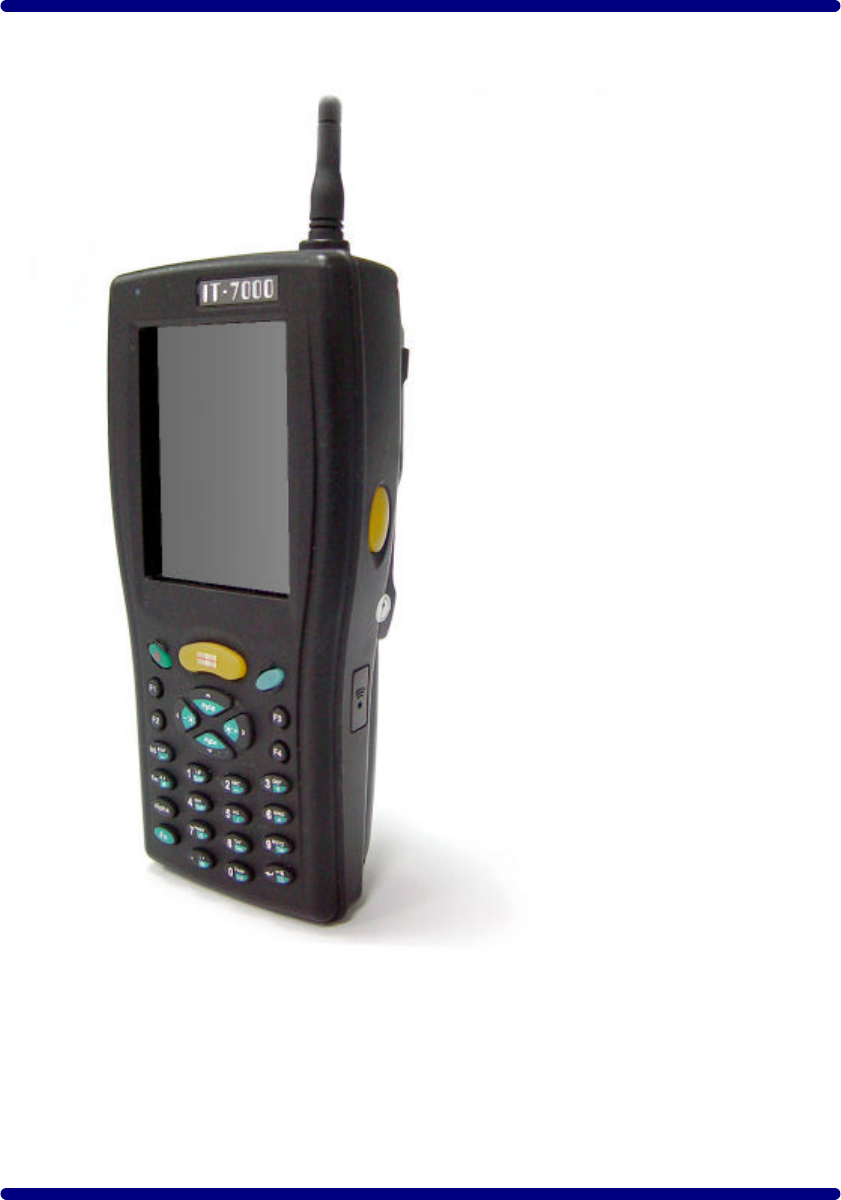
User’s Guide for IT7000 GPRS Model
WinCE. NET Rugged PDA
Dec. 06. 2005

Table of Contents
Chapter 1. Introduction
1.1: About this Manual P1-1
1.2: User and Product Safety P1-1
1.3: Insert IT7000 into Holster P1-2
1.4: Radio Frequency Interference Information P1-5
1.5: System specifications P1-6
1.6: Environment standard P1-7
Chapter 2. Getting Started
21: Handling the PDA
2.1.1 Starting the PDA P2-1
2.2: Initiating a Network Connection P2-1
2.3 GPRS Function
2.3.1 Setup GPRS program P2-3
2.3.2 Interface layout P2-5
2.3.3 SELECTING COMMUNICATIONS SETTING P2-10
2.3.4 MAKING A VOICE CALL P2-11
2.3.5 MANAGING PHONEBOOKS P2-12
2.3.6 DIALER P2-14
2.3.7 SMS P2-19
2.3.8 DIAL-UP NETWORKING P2-24
i

Chapter 1
Introduction
Congratulations on purchasing the IT7000 PDA with GPRS module, a Microsoft
Windows®CE .Net rugged PDA. Its special combination of features make it perfect for
using in a wide range of applications. These features as:
˙Small rugged lightweight form factor
˙Microsoft Windows CE. Net operating system
˙Flexible module design
˙Wireless mobility via 802.11b
˙Robust expansion capability
˙Long battery life
˙Transflective type color LCD display
˙Backlit keypad
1.1 About this Manual
The following chapters contained in this manual are:
Chapter 1: Introduction --- Present the general information about the PDA.
Chapter 2: Getting started --- Describe the basic use of the PDA.
Chapter 3:Setting – Provide basic instructions for customizing the PDA by adjusting
settings
Chapter 4:Communication--- Describe how to use all kinds of communication of the PDA.
1.2 User and Product Safety
◆ Do not stare into the laser beam directly or shine it into eyes.
◆ Never use strong pressure onto the screen or subject it to severe impact, as the LCD
panel could become cracked and possibility cause personal injury. If the LCD panel is
broken, never touch the liquid inside, for such contact would irritate the skin.
◆ Although the IT7000 PDA with GPRS module has been passed the test of IP54 standard
for water and dust resistance, avoid prolonged exposure to rain or other concentrated
moisture. For these conditions exceed the IP54 standard, and could result in water or other
contaminants entering into the PDA.
◆ Use only the approved AC Adapter with the PDA. Use of an unapproved AC Adapter
could result in electrical problems, or even cause a fire or electrical shock to the user.
P1-1

User Guide
Introduction
◆ Be sure that only authorized supplier are allowed to disassemble and reassemble the
device. If the device or parts has been damaged due to any wrong handling, shall void
the product and parts warranty.
◆ Always make back-up copies of all important data. Easy done by using a cable to
transfer data to the computer. Manufacturer is not liable for any data damages or data
loss caused by deletion or corruption by using of this device, or due to the drained
battery.
◆ Lithium-ion battery packs might get hot, explode, ignite and/or cause serious injury if
exploded by abusive using. Please follow the safety warnings listed as below:
˙Do not place the battery pack in fire or heat the battery.
˙Do not install the battery pack backwards so the polarity is reserved.
˙Do not connect the positive Battery pack with negative battery pack to each other with
any metal object (like wire).
˙Do not carry or store battery pack together with metal objects.
˙Do not pierce the battery pack with nails, strike the battery pack with a hammer,
step on the battery pack or otherwise put it to strong impacts or shocks.
˙Do not solder directly onto the battery pack.
˙Do not expose battery pack to liquid, or allow the battery contacts to get wet.
˙Do not disassemble or modify the battery pack. The battery pack contains safety
and protection devices, which, if damaged, may cause the battery pack to
generate heat, explode or ignite.
˙Do not discharge the battery pack using any device except for the specified device.
When it is used in devices other than the specified devices, the battery pack can be
damaged or its life expectancy reduced. If the device causes any abnormal current to
flow, it may cause the battery pack to become hot, explode or ignite and cause
serious injury.
˙In the event the battery pack leaks and the fluid gets into one’s eye, do not rub the
eye. Rinse well with water and immediately seek medical care. If left untreated, the
battery fluid could cause damage to the eye.
1.3 Insert IT7000 into Holster
Please insert bottom of IT7000 into holster at first, and keep LCM face to outside in this
uni-direction way same as the below figure.
P1-2
To comply with FCC RF exposure rule, please use only the supplied holster (the supplied holster
does not have any metallic components in the structure and will limit this product only in an
orientation that back-face will toward user’s body), Third-party belt-clips, holsters, and similar
accessories may not comply with this requirement and should be avoided.
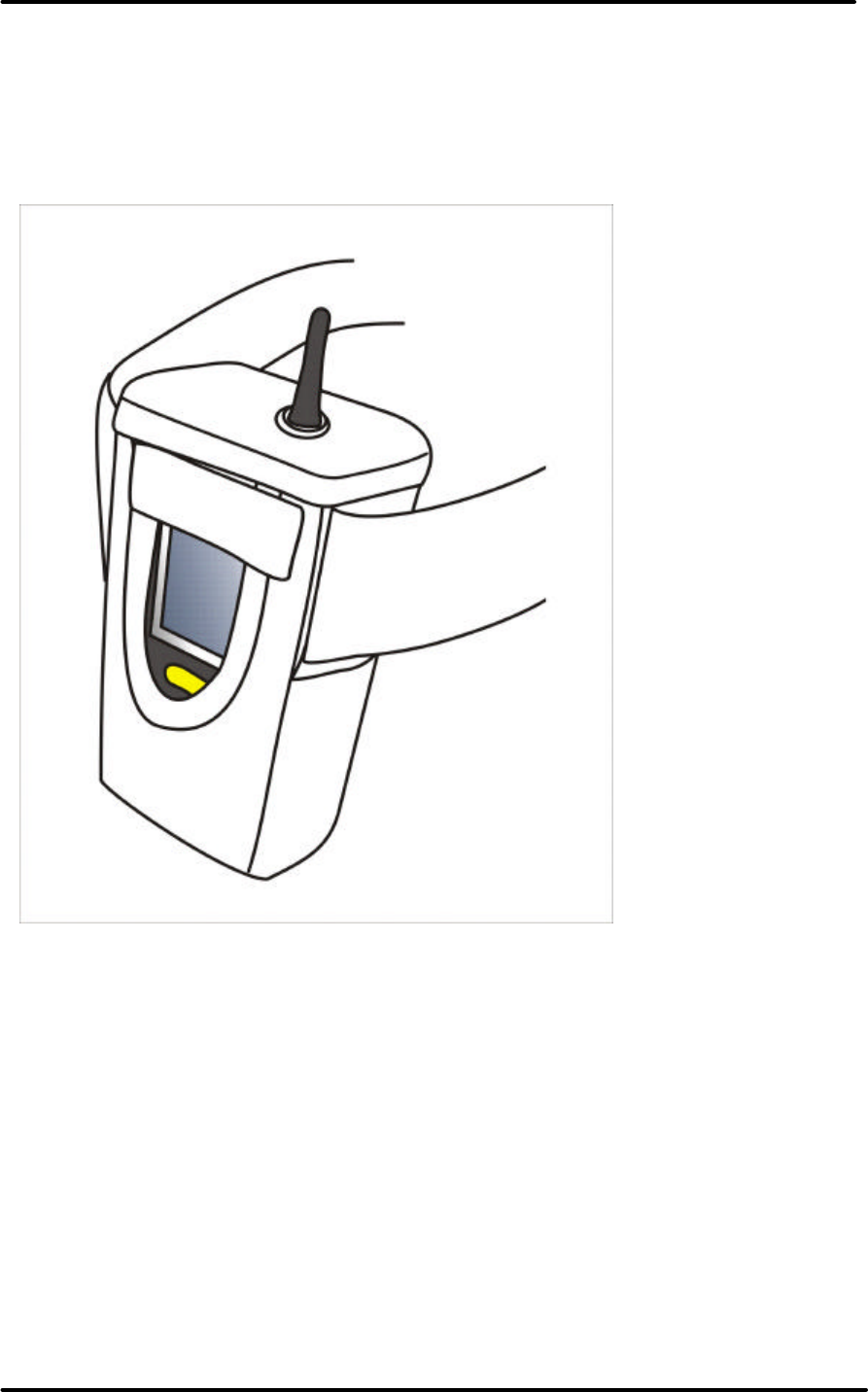
User Guide
Introduction
P1-3

User Guide
Introduction
1.4 Radio Frequency Interference Information
1.4.1 FCC Radiation Exposure Statement:
This equipment has been tested and found to comply with the limits for a Class B
digital device, pursuant to Part 15 of the FCC Rules. These limits are designed
to provide reasonable protection against harmful interference in a residential
installation. This equipment generates, uses and can radiate radio frequency
energy and, if not installed and used in accordance with the instructions, may
cause harmful interference to radio communications. However, there is no
guarantee that interference will not occur in a particular installation. If this
equipment does cause harmful interference to radio or television reception, which
can be determined by turning the equipment off and on, the user is encouraged
to try to correct the interference by one of the following measures:
- Reorient or relocate the receiving antenna.
- Increase the separation between the equipment and receiver.
- Connect the equipment into an outlet on a circuit different from that
to which the receiver is connected.
- Consult the dealer or an experienced radio/TV technician for help.
FCC Caution: Any changes or modifications not expressly approved by the party
responsible for compliance could void the user's authority to operate this
equipment.
This device complies with Part 15 of the FCC Rules. Operation is subject to the
following two conditions: (1) This device may not cause harmful interference, and
(2) this device must accept any interference received, including interference that
may cause undesired operation.
P1-4
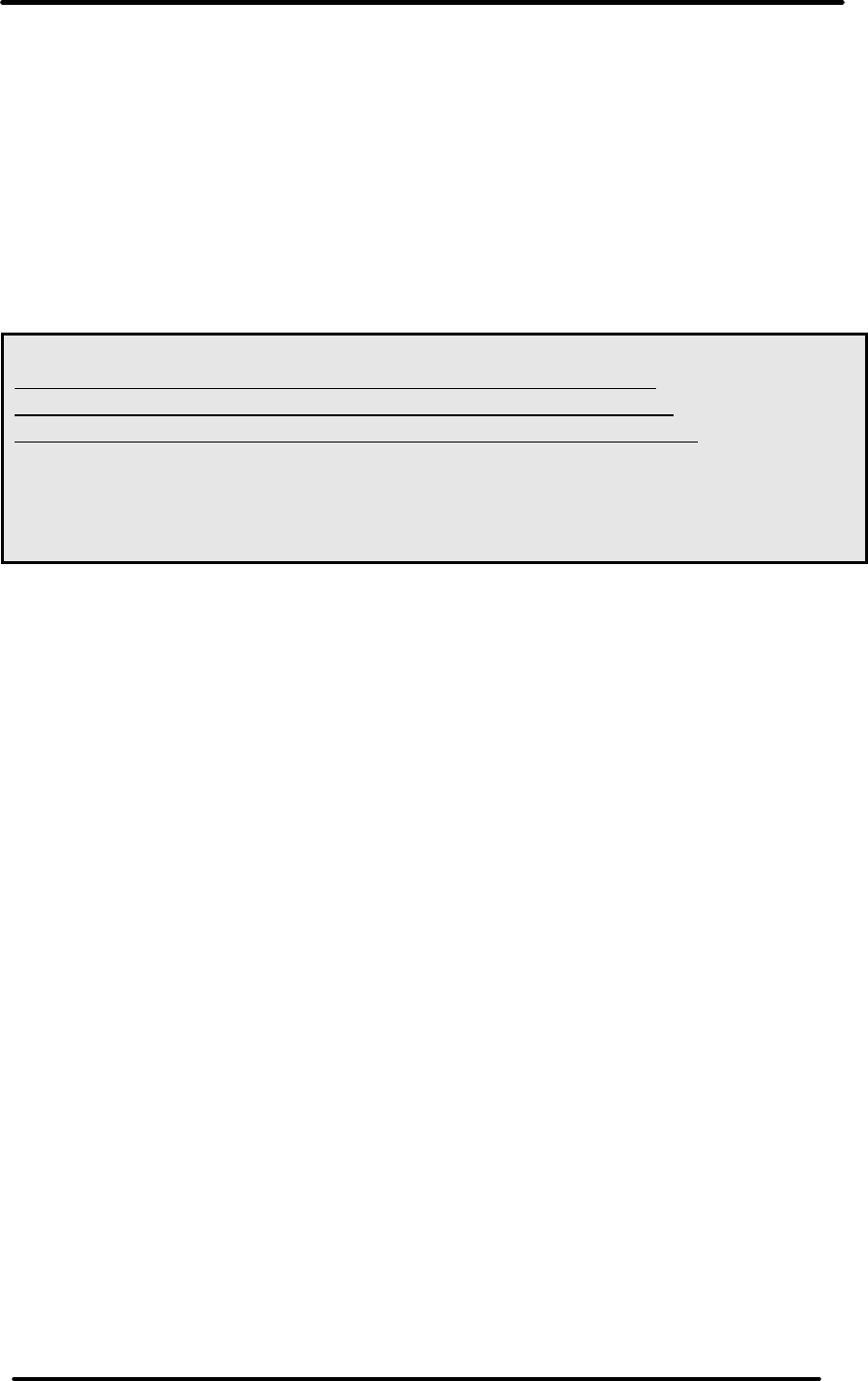
User Guide
Introduction
IMPORTANT NOTE:
FCC Radiation Exposure Statement:
This equipment complies with FCC RF radiation exposure limits set forth for an
uncontrolled environment. To maintain compliance with FCC RF exposure
compliance requirements, please avoid direct contact to the transmitting antenna
during transmitting.
This transmitter must not be co-located or operating in conjunction with any other
antenna or transmitter.
This equipment has been SAR-evaluated for normal using condition.
Caution:
The FCC ID of IT7000 for GSM function only is SPY-IT7000PDT-G
The FCC ID of IT7000 for WLAN function only is SPY-IT7000PDT-W
The FCC ID of IT7000 for Bluetooth function only is SPY-IT7000PDT-B
Note: 1.A firmware set the used function of each FCC ID when shipping.
2.Only its bottom side of IT7000 with GPRS module will touch the
human body during handling the IT7000 by hand because The
GPRS Module is placed the bottom side of IT7000.
P1-5
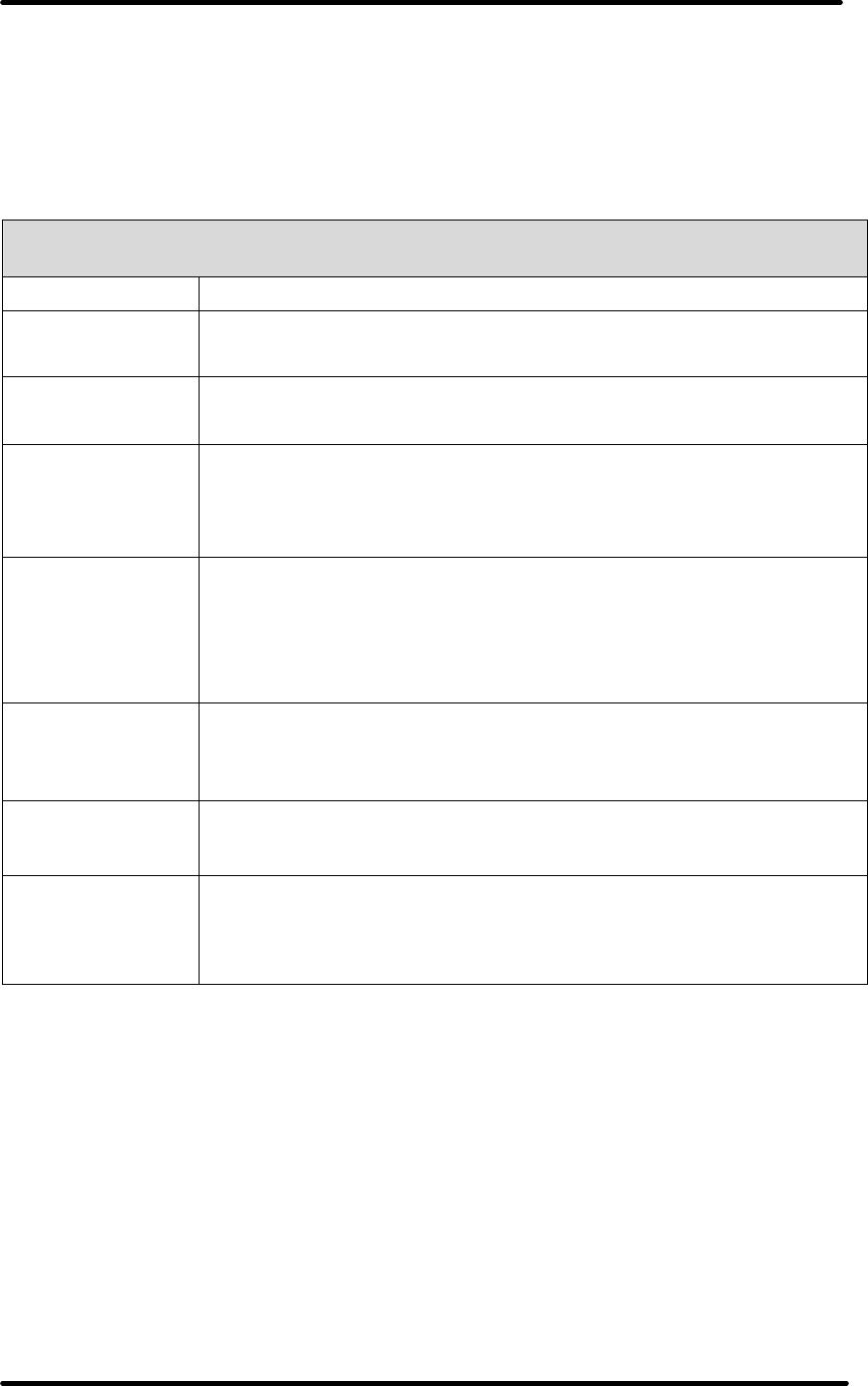
User Guide
Introduction
1.5 System Specifications
The detailed specifications as follows. Unless otherwise noted, all the specifications are
subject to change without prior notification.
System Specification
IT7000
Processor - Intel® XScale PXA255 400Mhz 32 bits RISC
Memory - 64MB (M-System) Flash ROM
- 64 or 128MB SDRAM
Display - Support 240 x 320 TFT 256K Color LCD
- Transflective type TFT LCD with back light
Radio Support
-Wireless LAN: 802.11b
-Siemens MC55 Tri-Band GSM/GPRS Module:
900/1800/1900MHz
Communication
Ports
-Infrared: One IrDA 1.2 compliant port
-USB: Support USB v1.1 both host and client
(PDA and Cradle)
-Serial: RS232 via optional cable or Cradle
Scan Engine -Default: Symbol SE800
-Optional: Symbol SE900, Opticon VLM4000,
Intermec EV-10 CCD, HHP 4080 2D Imager.
Expansion Slot - One Compact Flash Type-II slot (support 3.3V)
- One SD Card slot (support SD memory)
LED
- One three-color LED for Alarm notification (Blue
) and charger
indicator (RED & Green)
- One two-color LED for scanner indicator
P1-6
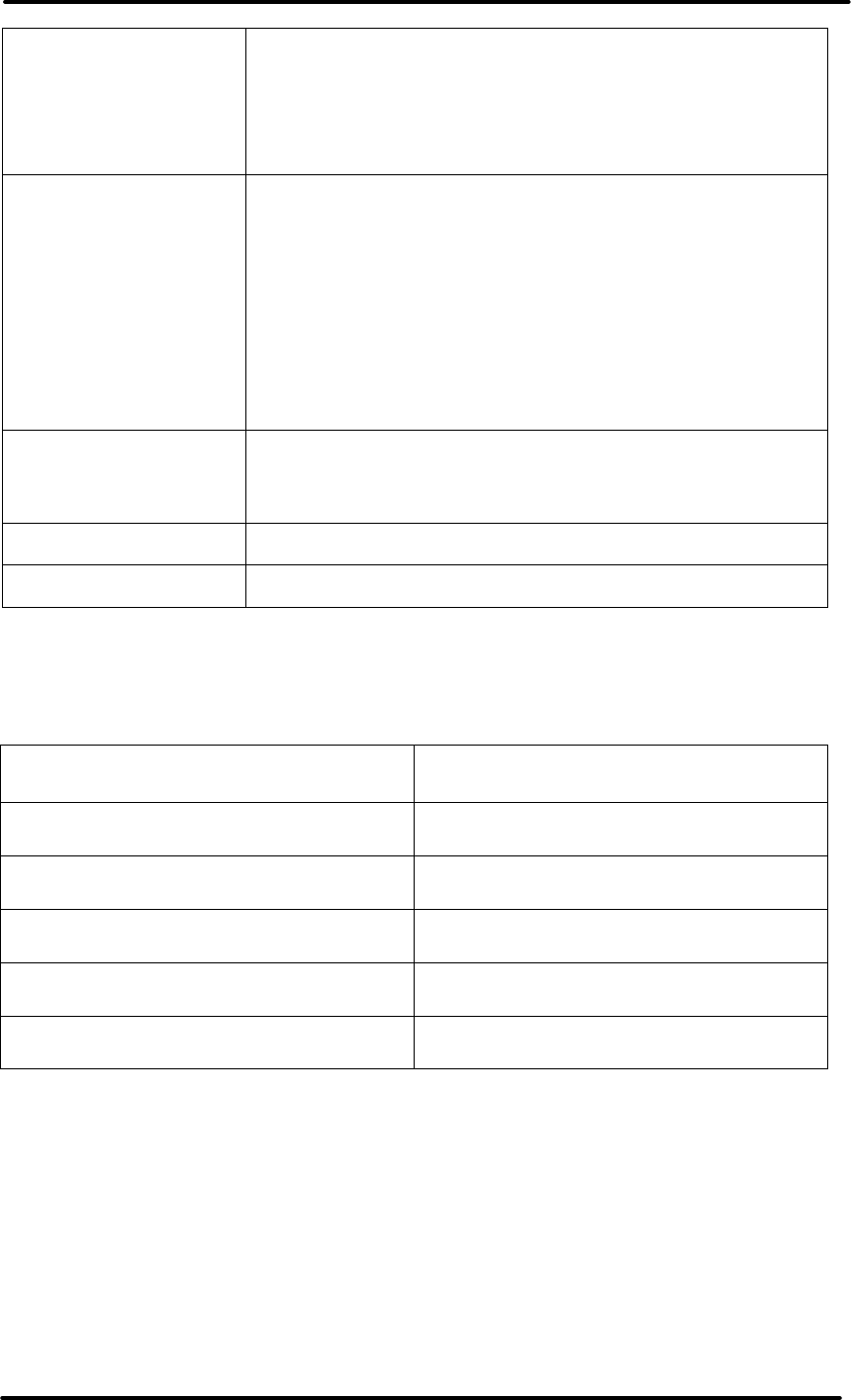
User Guide
Introduction
Power System
- Built in 7.4V, 2200mAh Li-ion removable battery pack
(10 operation hours
& 100 standby hours in 64MB
DRAM and 64 ROM module)
- 140mA
rechargeable backup battery (It will hold the
system data at least 3 hours)
Button/Key
- Power/Front light on/off button
- LED light Key
- 4-way navigation button
- 4 Application Keys
- 3 Scanner Enable Keys
- SW Reset input button
-16 alphanumeric keyboard
Dimensions and
Weight
- Dimensions: 91/76mm (W) x 187mm (L) x 58/43
mm
(H)
- Weight: 350g
Color - Black
Software - Microsoft WinCE.NET 4.2 (Professional Version)
1.6 Environment Standard:
Storage Temperature -20℃~60℃
Operating Temperature -10℃~50℃
Humidity 5% to 90% (non-condensing)
Drop 5ft (1.5m) drop to concrete
Water & Dust proof IEC 529 rating IP54DW
Vibration MIL STD 810F
P1
-
7
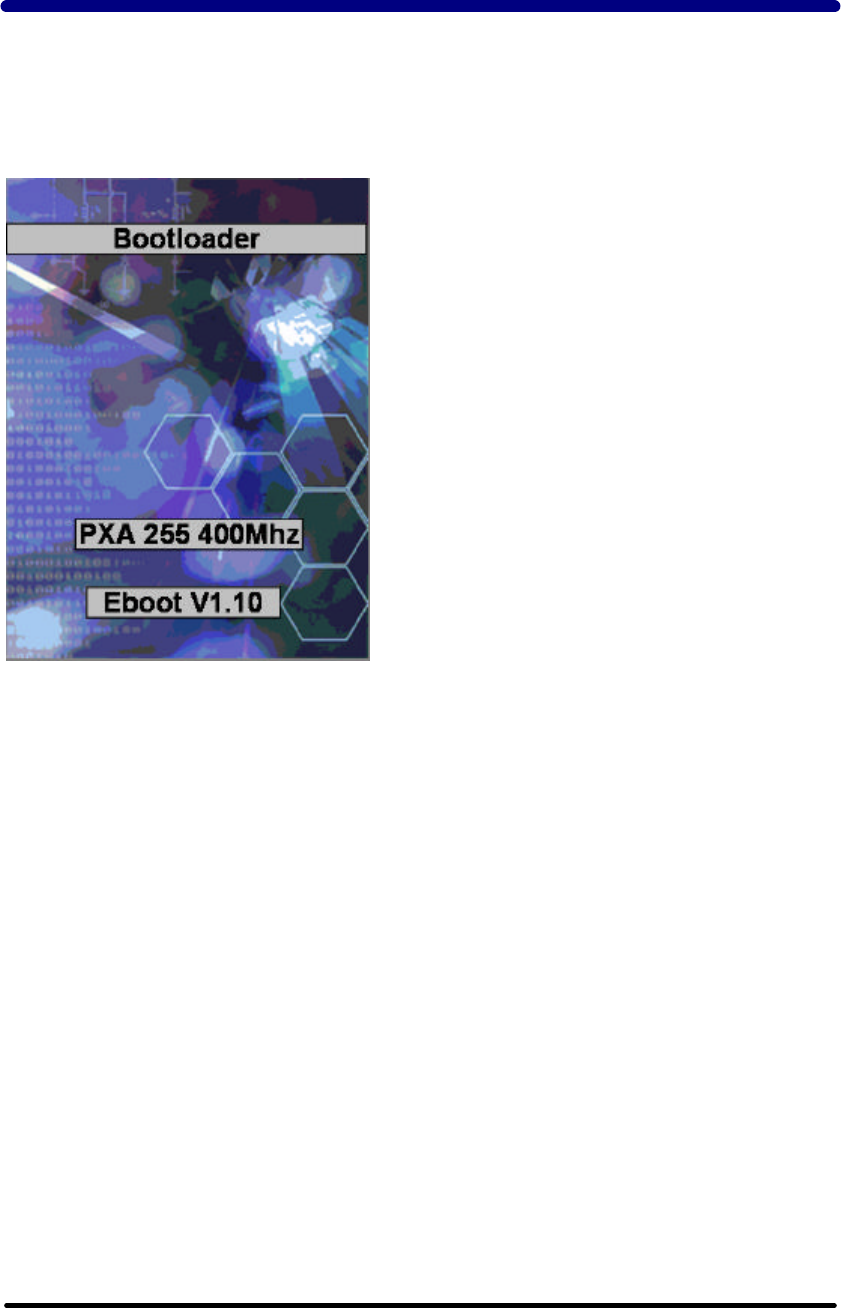
Chapter 2
Getting Started
2.1 Handling the PDA
2.1.1 Starting the PDA
Press the Power key to turn on/off the PDA. If the PDA does not power on, perform a
cold boot.
Figure 2-1
2.2: Initiating a Network Connection
To tap the icon at Task bar, then a Wireless LAN screen “PRISMNDS1”(Figure 2-2-
1), select page “Wireless Information”. There is a list of Wireless access points.
Select one by double-clicking the access point you want. Or double-click “Add New “ to
add a new access point.
To Click “Connect” icon to connect WLAN with Access point.( Figure 2-2-2)
To select page “ Disable” to disable WLAN to save power consumption. ( Figure 2-2-3
& Figure 2-2-4)
P2-1
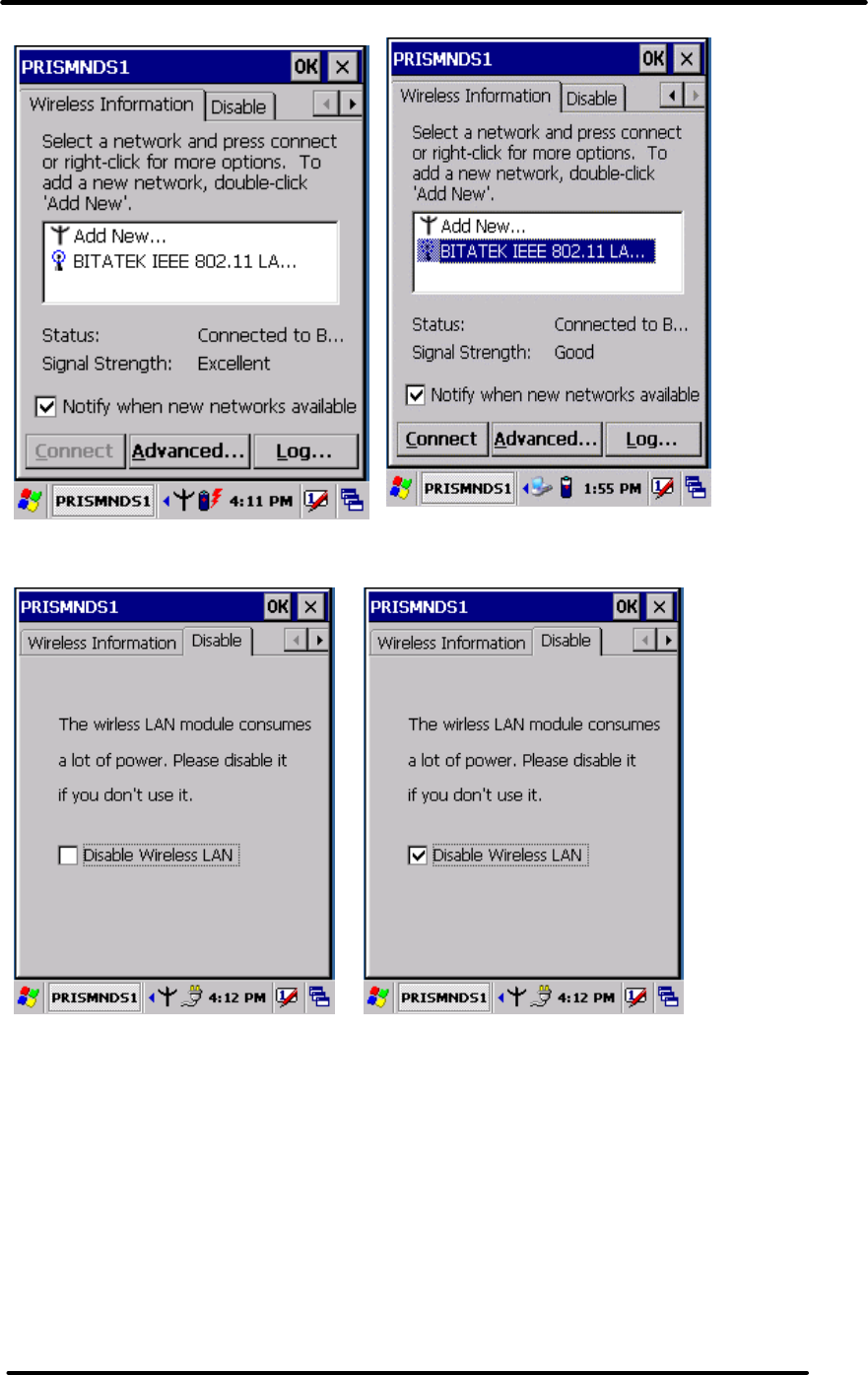
User Guide
Getting Start
Figure 2-2-1 Figure 2-2-2
Figure 2-2-3 Figure 2-2-4
P2-2
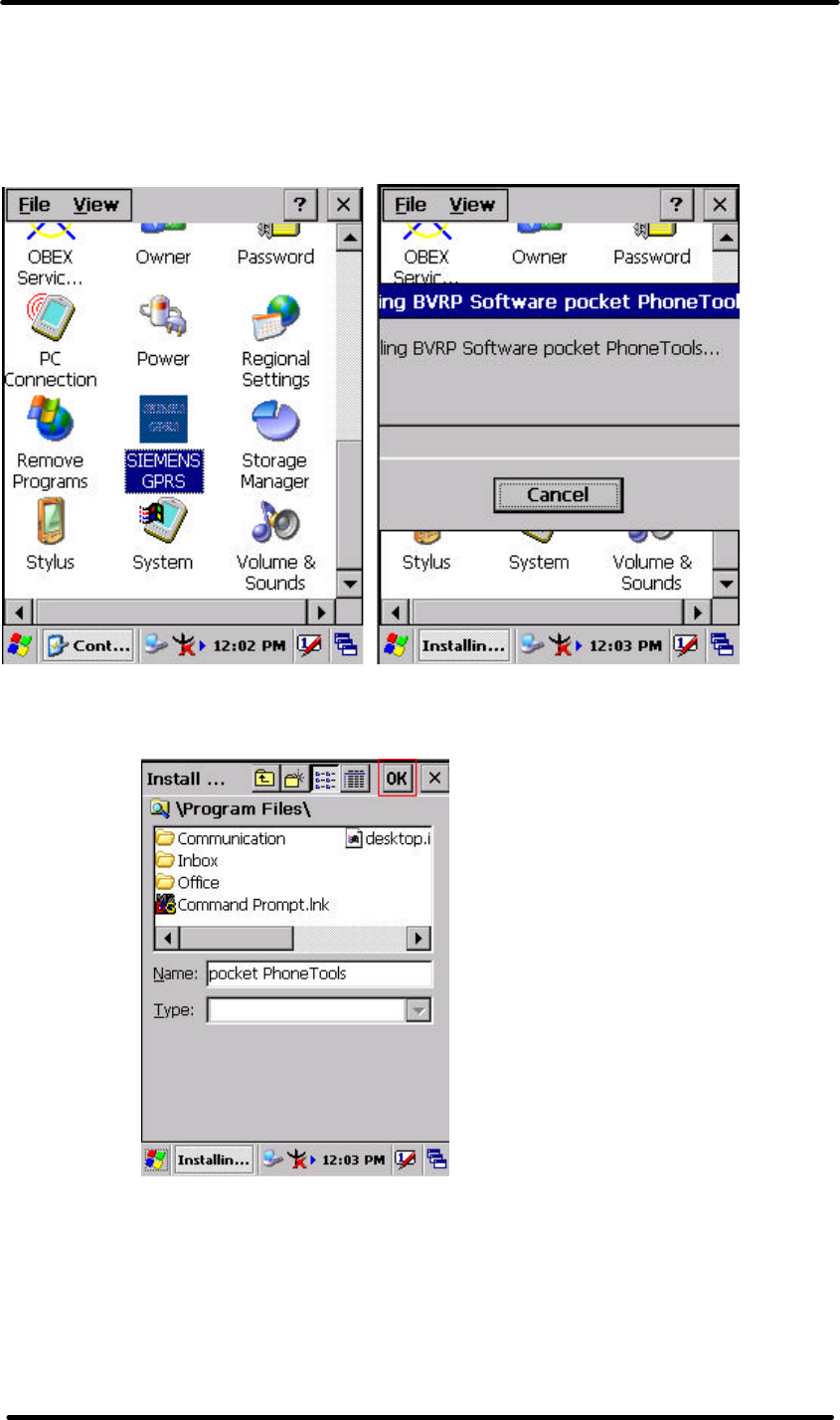
User Guide
Getting Start
2.3: GPRS Function:
2.3.1 Setup GPRS program
1. Put the SIM card into SIM slot of PDA ( See Figure 2-3-5)<Must Turn off PDA>
2. Enter into Start ? SettingsàControl PanelàSIEMENS GPRS (Figure 2-3-
1)àTag ”OK”
3. A setup screen is showing as Figure 2-3-2
Figure 3-2-1 Figure 3-2-2
4. Please tag “OK” ICON to continue the program setup(Figure 3-2-3)
Figure 2-3-3
5. The GPRS program will be finalized setup after the blue bar is fulfilled in the below
figure.(Figure 2-3-4)
P2-3
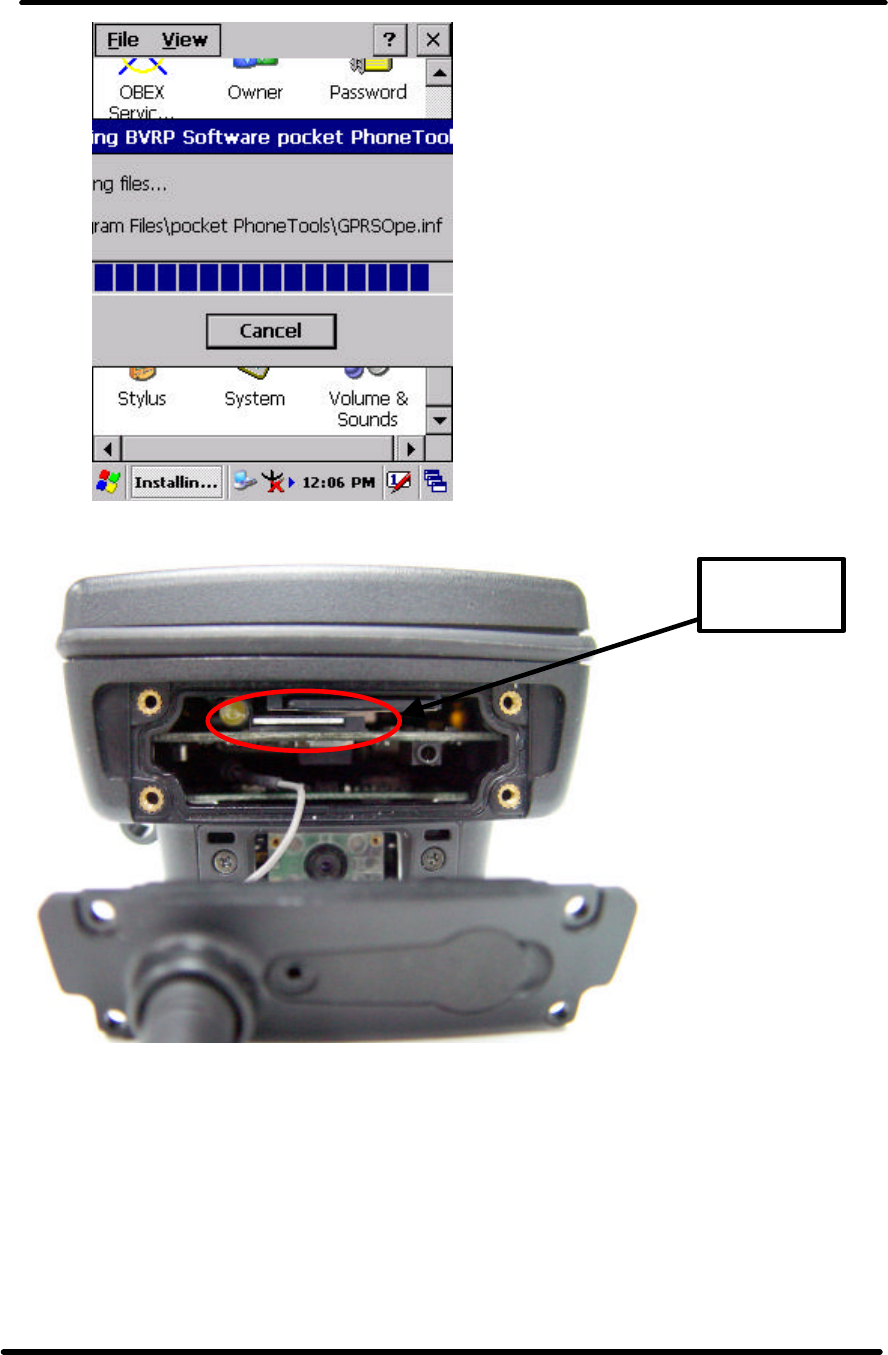
User Guide
Getting Start
Figure 2-3-4
Figure 2-3-5
P2-4

User Guide
Interface layout
2.3.2 INTERFACE LAYOUT
Depending
on
options available
and the capabilities of
your PDA,
the main
interface enables
you
to:
-
Look up all
your messages
using
the
Inbox
,
Outbox
and
Sent
icons.
-
Create and send
Fax
and
SMS
messages.
-
Make a phone call
using
the
Dialer
, which also enables you to access
SMS and fax
functions.
-
Manage
several
Phonebooks
.
-
Look
up
WAP
sites.
-
Connect to
the Internet.
Note:
When
you
start the
application
for
the first time,
the communications
settings
screen is displayed
automatically. You
will
not
be able to
access
the main interface
until
these settings
have been
specified. See
Selecting
communications settings, page
2-10.
Reading messages
Inbox
Clicking the
Inbox
icon
displays a list of
all
messages
received at
the center of the
screen.
Unread messages on
this list appear in bold.
The
message content is displayed in
the lower frame.
P2-5
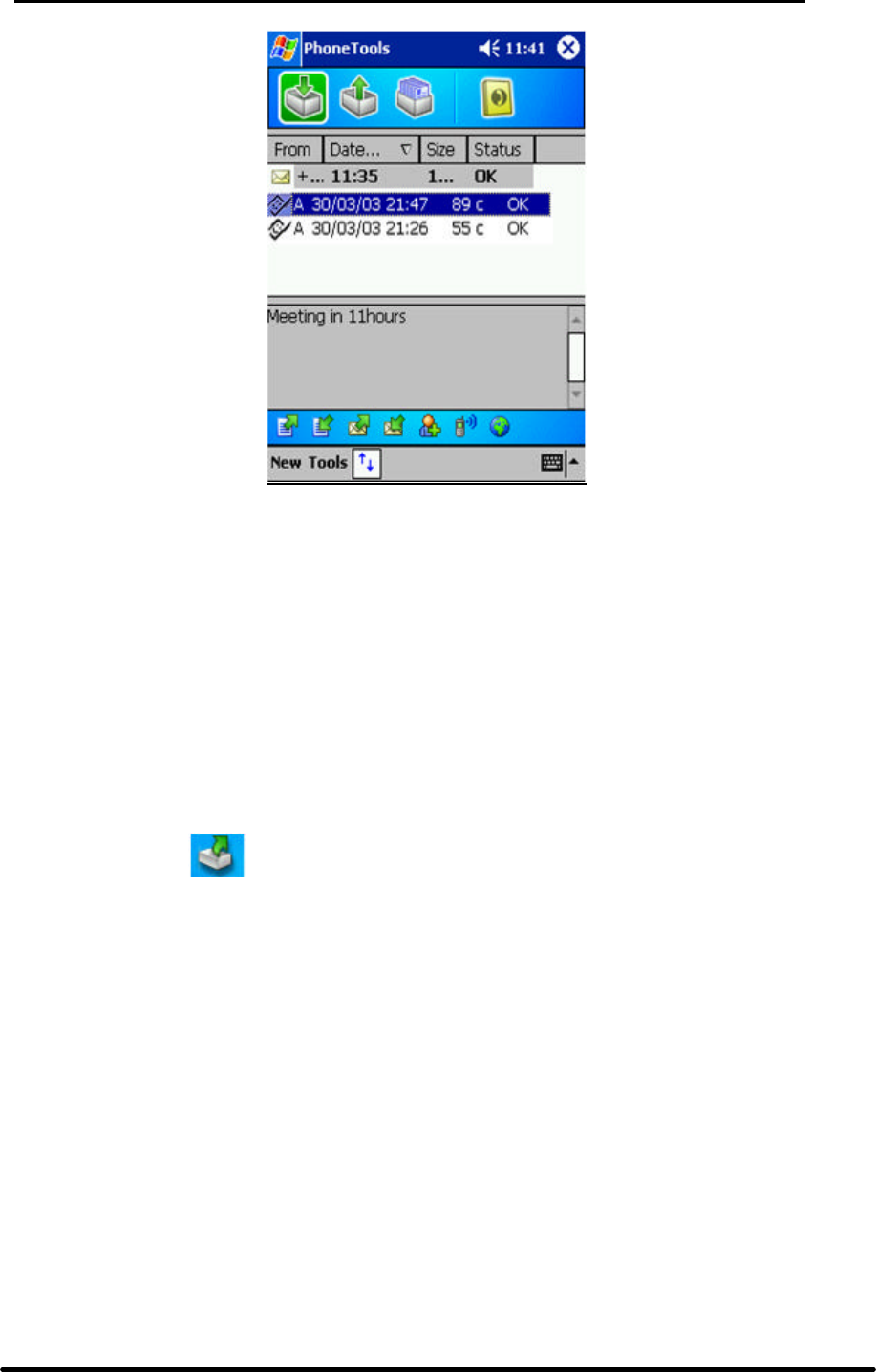
User Guide
Interface layout
Depending
on
the
type of message, in order
to
send, see
properties, move, resend,
display,
annotate or delete
a
message on the list:
1.
Select the message and hold the
selection with
the stylus for a few
seconds
until a
context
menu is displayed.
2.
Select the desired option.
3.
Depending on the option
selected,
follow the usual procedure
or click
Cancel
or the
OK
icon,
located
in
the top right-hand corner of the screen,
to return to
the main
interface.
To collect your messages, click
on the
Tools
menu, then
Retrieve SMS
from
the list
that
shows
up.
Messages received are placed in
the
Inbox
automatically.
Outbox
Clicking the
Outbox
icon displays a list of
all
messages
sent at the center of the
screen. The
message content is displayed in
the lower frame.
This is a listing of messages
waiting to
be sent or
sent
from
the application as well
as those downloaded from
your mobile
phone.
P2
-
6
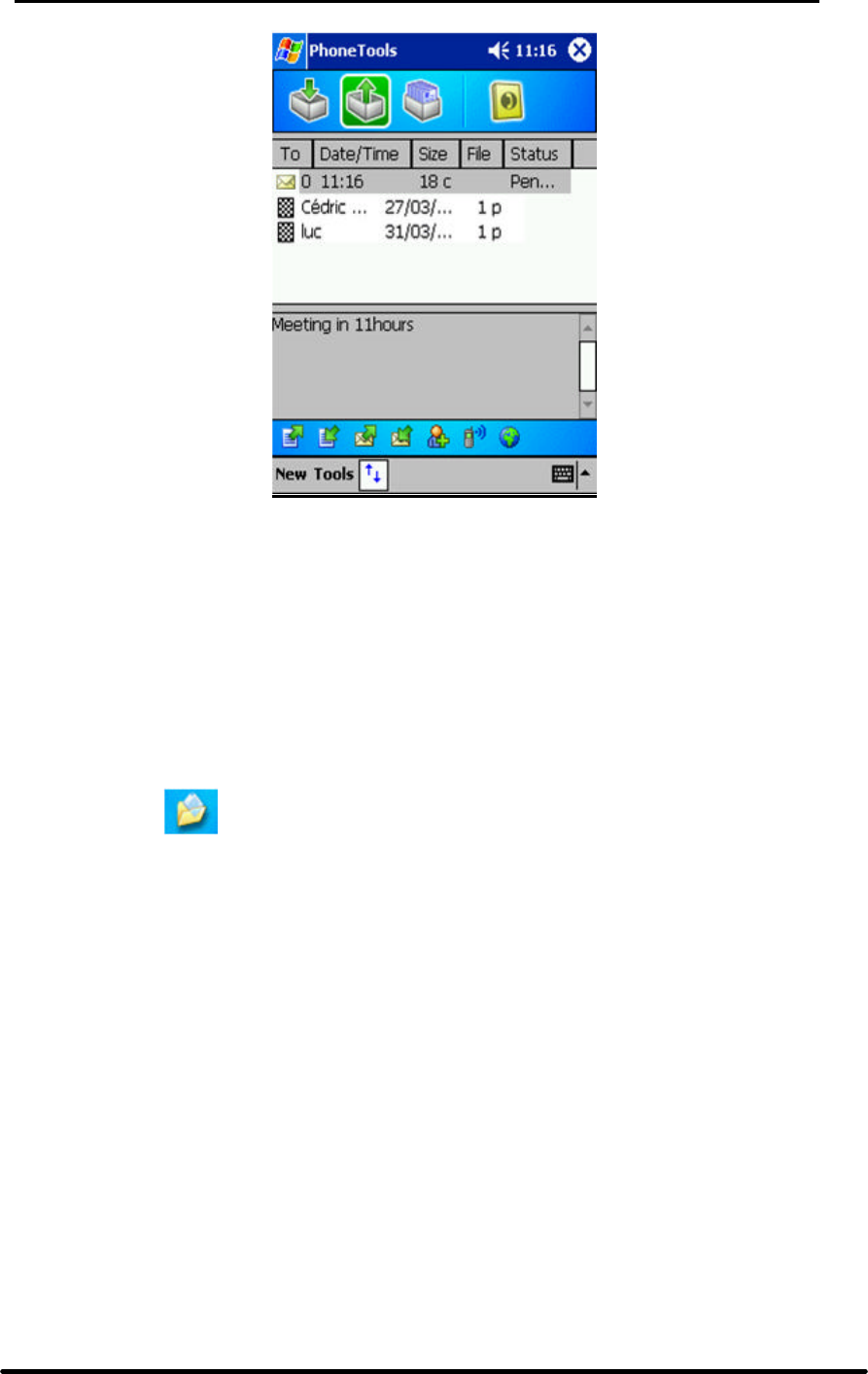
User Guide
Interface layout
Depending
on
the
type of message, in order
to
send, see
properties, move, resend,
display,
annotate or delete
a
message on the list:
1.
Select the message and hold the
selection with
the stylus for a few seconds
until a
context
menu is displayed.
2.
Select the desired option.
4.
Depending on the option
selected,
follow the usual procedure
or
to
return
to
the
main
interface click the
Cancel
button
or
the
OK
icon, located in
the
top
right- hand
corner of the
screen.
Sent box
Clicking the
Sent
icon will display
the list
of messages sent from the
outbox. The content of
the
selected message is
displayed in the
frame.
To send, see
properties, transfer,
display,
annotate or delete a message from the list:
1.
Select the message and hold the
selection with
the stylus for a few
seconds
until a
context
menu is displayed.
2.
Select the desired option.
3.
Depending on the option
selected,
follow the usual procedure
or click the
Cancel
button or
the
OK
icon, located in
the
top
right-hand corner of the
screen, to
return
to the
main
interface.
P2-7
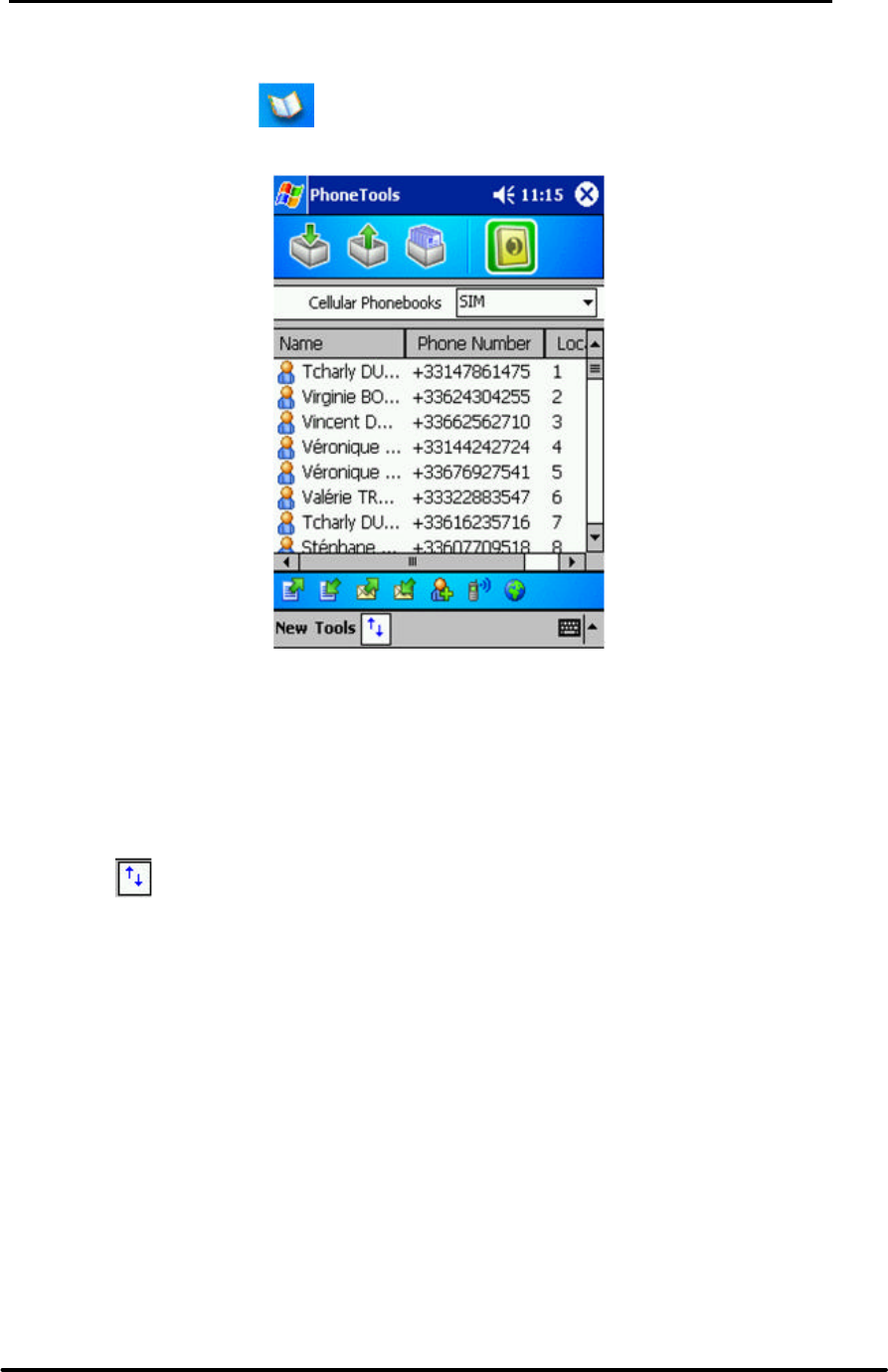
User Guide
Interface layout
Phonebooks
Clicking on the
Phonebooks
icon
displays a drop-down list
containing the
phonebooks you
have
created or imported. Select
the one you
wish
to
set
as
the default
phonebook from
the list to be
looked up or edited.
If the
drop-down list is empty and
you
would like to
import contacts
from your mobile phone, select the
Tools
>
Read a
phonebook
menu.
See Managing Phonebook,
page 2-12.
Icons and menus
Display icons
Clicking the icon
located
at
the
bottom of the
screen
symbolizing
two arrows on a blank page,
displays the fast access icons
for
available functions (which are as
follows,
from left
to right: send
and
receive
Fax
, send
and receive
SMS
,
Phonebook
,
Dialer
or
Remote network access
).
Click
this
icon again to hide them.
P2-8

User Guide
Interface layout
Drop-down menus
The
New
and
Tools
drop-down
menus have several
functions, depending on the
context
and options available:
New menu
Click on
the
New
menu
at the
bottom of
the screen,
then select:
o
SMS
:
follow
the steps to
prepare and send
SMS messages as described on page
26.
o
Phonebook
. To create a
phonebook, see Managing Phonebook,
page
2-10.
o
Phonebook Contact
. To
add a
contact to your phonebook, see Managing
Phonebook,
page
2-10.
o
Call
.
To speed-dial
the
telephone
number for one of your
Contacts, see page
2-11.
Tools menu
Click on
the
Tools
menu at
the bottom
of
the screen, then
select:
o
Read SMS
messages
.
The application retrieves
the
SMS
messages. See
SMS,
page 27.
o
Look up a phonebook
. To look
up and download
a phonebook:
the one
in
your
mobile phone or
the one
in
your SIM
card. See
Phonebook, page
2-8.
o
Reply
: This command
will be available if
a message is
selected in
the Inbox.
o
Resend
. To
resend
the selected
message.
o
Transfer
. To transfer the selected message.
o
View
.
To
display the content of
the selected message.
o
Annotate
. To annotate
a
fax which is
to be resent, transferred or
saved.
See
Fax, page
17.
o
Delete
. To delete one or more
messages selected
from the list.
o
Select all
. To select
all
messages on
the list.
o
Options
.
To
configure
the application's communications settings. See Settings,
page 11.
o
Dialer
.
To
make a call
directly from
the application. See
Dialer,
page 2-14.
o
Dial-up networking
. To
manage remote access networks
such as
Internet or
WAP services. See
Dial-up
networking, page 2-24.
o
About
.
To access
information about the application.
o
Exit
.
To shut
down the application.
P2-9
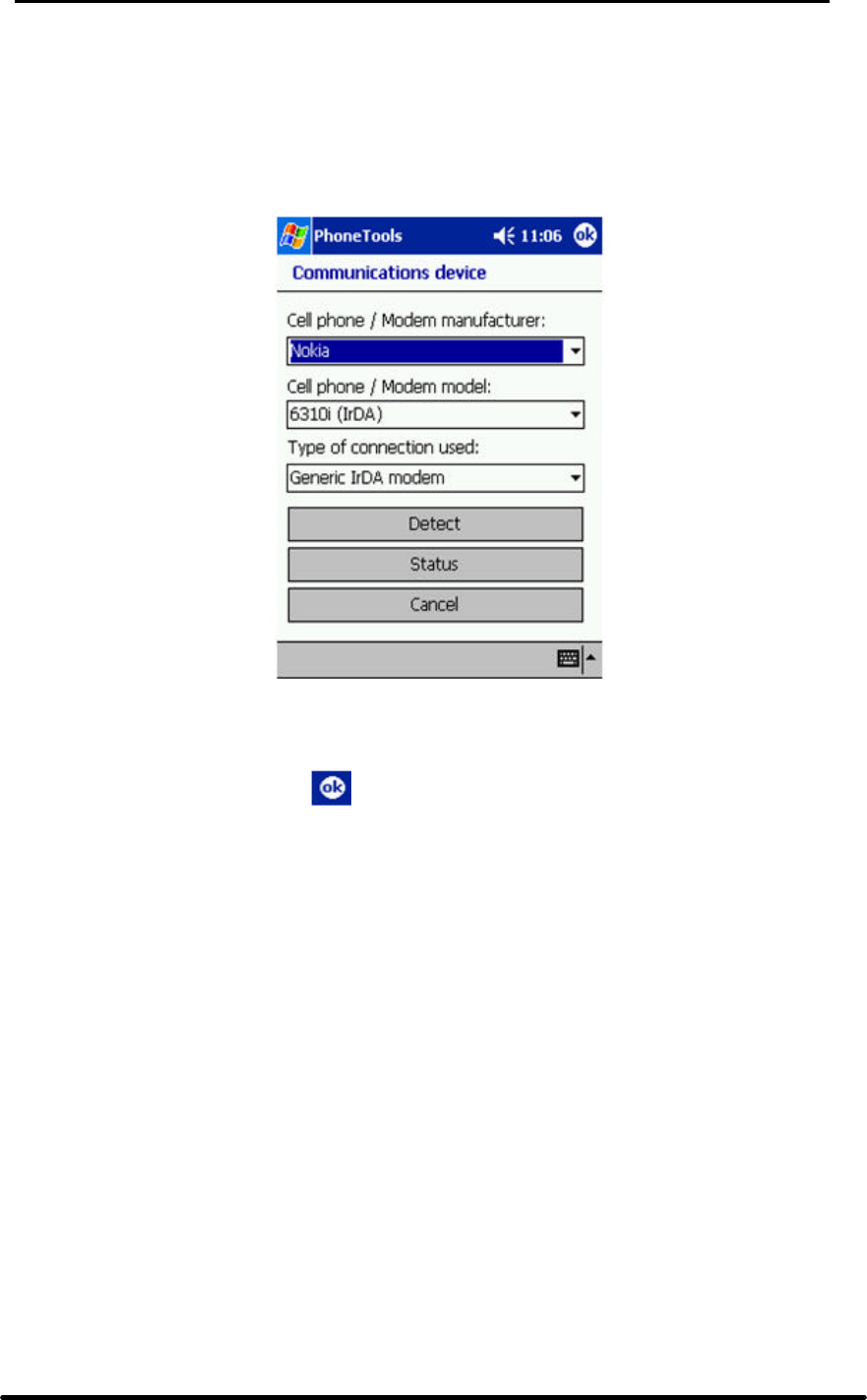
User
Guide
Selecting communications
settings
2.3.3 SELECTING COMMUNICATIONS SETTINGS
Before using the communications
features, ensure
that the communications port
and
the equipment
you are using have
been declared correctly.
Communications tab
1.
Select
Tools>Options>
Communications
2.
Select
the
Manufacturer
and the
Model
of
your equipment (modem or
telephone).
3.
Select
Connection type
being used
.
4.
Click
the
icon
located
at the
top
right-hand corner of
the screen
to
confirm.
The
Detect
button prompts
you
to search
your equipment automatically and to
configure
the
application.
The
Status
button
returns information on your equipment.
P2-10

User
Guide
Making a voice
call
2.3.4 MAKING A VOICE CALL
1.
Select
Call
from the
New
menu in
the main screen.
The contacts list
shows up.
2.
Select the
contact you wish
to call.
If
this contact has
more than one telephone
number listed,
select
one of them and click
Continue
.
3.
Click
OK
to make the
call
and follow
the instructions displayed on screen. This
function
enables you
to make a
call
rapidly from the
main screen.
If your mobile phone supports
the
Dialer function
you
can also
make
a
voice call using it.
See page
20 for
more details on
the Dialer.
P2-11
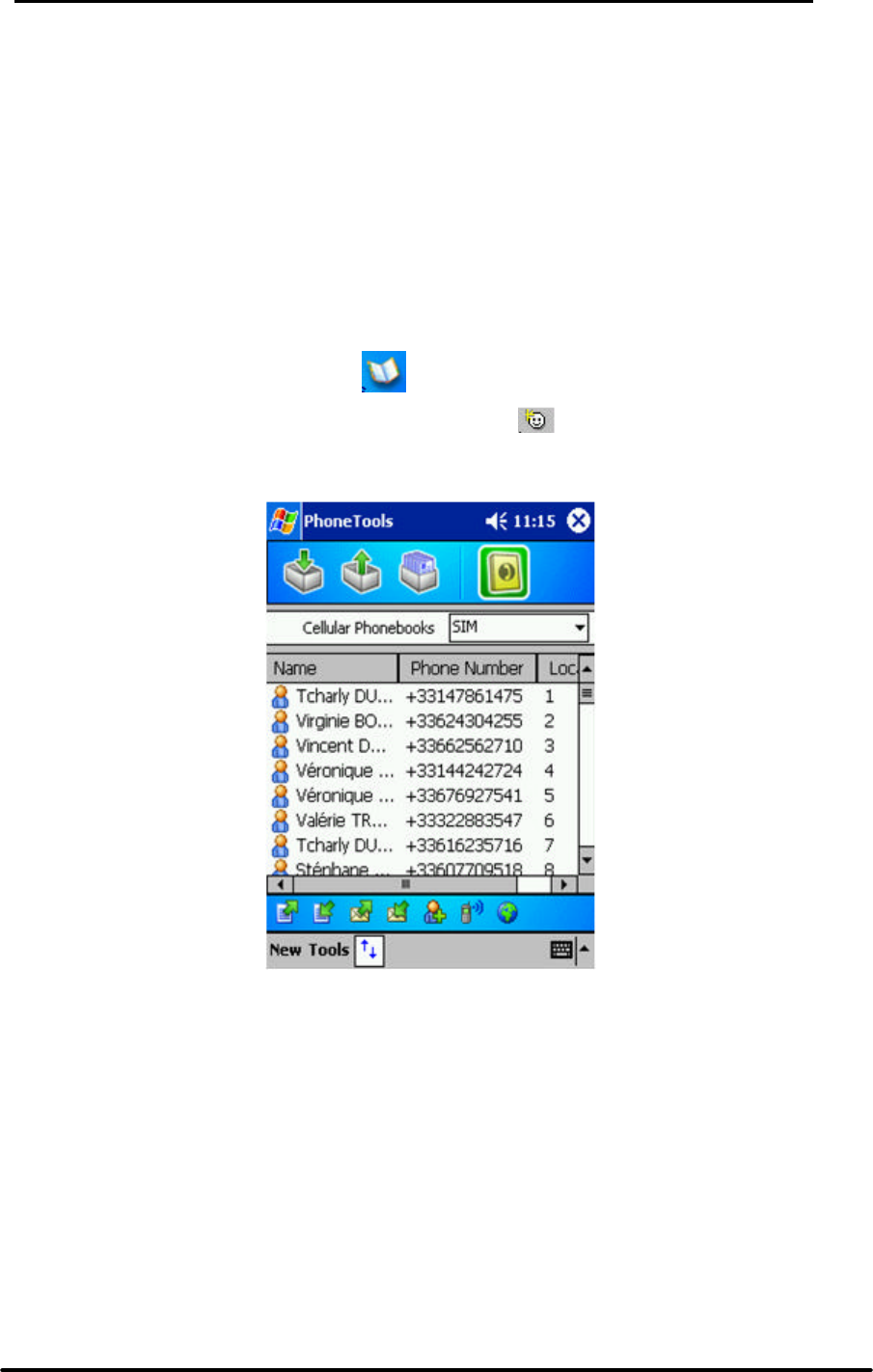
User Guide
Managing
phonebooks
2.3.5 MANAGING PHONEBOOKS
Pocket PhoneTools
enables you to create
phonebooks, import contacts
listed
in
your
mobile phone
(memory + SIM card)
and synchronize various phonebooks.
Creating a phonebook
1.
Select
New
>
Phonebook
.
2.
Enter
the phonebook name.
3.
Click
OK
.
Adding a contact
1. Click
the
Phonebooks
icon then select
from
the drop-down list
the
phonebook to which
you wish
to add a
contact.
2.
Select
New
>
Phonebook contact
or
click .
3.
Enter
Recipient Name
and
Phone Number
.
4.
Click
OK
. The
entry will be added
to
the
contacts
P2-12

User Guide
Managing
phonebooks
Renaming a phonebook
1.
Click
the
Phonebooks
icon then
select the
phonebook
to
be
renamed from
the
drop-down list displayed.
2.
Select
the
Tools
>
Change
menu.
3.
Type
your changes in
the
Name
field
and click
OK
.
Changing a contact
1.
Click
the
Phonebooks
icon then
select the
phonebook containing the
contact
to be
changed from
the
drop-down list displayed.
2.
Select the
contact you wish
to change.
3.
Select
Tools
>
Change
using the
stylus and
hold the
pressure until
a
context menu is displayed.
4.
Select
the
Change
option
in this menu. A new
window
is displayed.
5.
In
the
Correspondent
tab,
enter your
changes in the
Name
,
Number
and
Comments
fields
and click
OK
.
Downloading your mobile phonebook
1.
Select
the
Phonebooks
folder.
2.
Select
Tools
>
Retrieve phonebook
.
3.
When prompted by the application,
select
the memory where the phonebook
you want
to download is
stored.
4.
Click
OK
. Your
phonebook is
downloaded.
Transferring a phonebook to your mobile phone
1.
In
the
Phonebooks
folder, select
the phonebook to be
transferred.
2.
Select
Tools
>
Transfer to
cellular
.
3.
When prompted by the application,
select
the memory to which the phonebook
Is
to be transferred.
4.
Click
OK
. Your
phonebook is
transferred.
P2-13

User Guide
Dialer
2.3.6 DIALER
The
Dialer
module simulates
the operation of a mobile phone in
your
PDA. It enables
you
to:
y
Make calls in
various ways:
-
by directly
selecting an entry
in the
Contacts
folder of your
PDA.
-
by
selecting from a
Fast calls
list
you
will have pre-programmed.
-
by
entering a number
directly using
the
keyboard.
-
by redialing one of
the
last 10
numbers dialed.
-
using
the missed calls log
if
the caller has not
withheld
his/her
number.
y
Receive
calls showing, where possible,
the last and first
names of your caller and
playing a
tune identifying
the
Contacts
category to
which your
caller
belongs.
y
Reject
incoming
calls.
y
Save outgoing,
incoming as well
as
missed calls in
call
logs.
y
Send digits
with the call
to enable
navigation
across
most voice servers.
y
Save the
number
of your message
system for
speed dialing.
y
Check microphone and
speaker volume for certain items of equipment.
y
Send and receive SMS
messages.
y
Access
the
Remote network
access
module to
connect
to
the
Internet using a single
button.
y
Read
signal strength
and battery
level
of your mobile directly
when
external equipment is
being used
or of
your
PDA
for an internal card.
y
Request
the
dialer to be called
automatically on
starting up
the application.
Warning!
Certain dialer functionalities may be disabled due to
incompatibility
with
the
communications
equipment.
Accessing the dialer
Starting from the main
interface, select
the
Tools
menu then
the
Dialer
option
or
click . The dialer
initializes
your
communications
equipment then
displays signal strength and battery level as well
as
the name of your service
provider.
The keyboard will
be
enabled once
the initialization stage is
complete.
P2-14
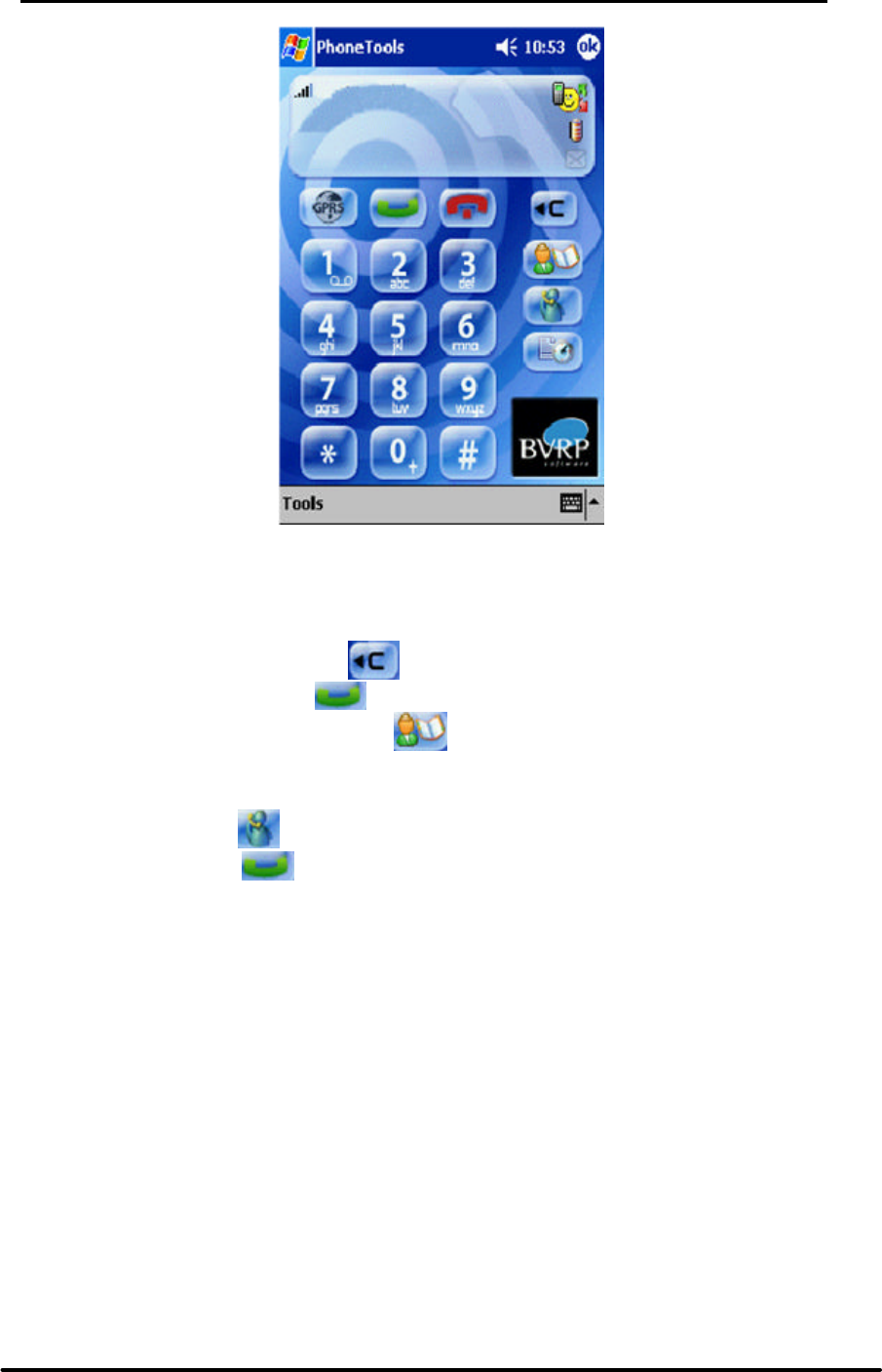
User Guide
Dialer
Dialer:
Making a voice call
1.
Access the dialer and
use one of the
following
methods:
-
Direct entry
,
dial the
number
using
the
keys
on
the numeric keypad. To delete or correct
the last digit
displayed, click on
the icon
showing an arrow
pointing to
the left
and
a C. To make the call,
click
the icon
showing a green receiver.
-
From
Phonebook
, click on
the
Contacts
icon to
retrieve
the number
you are calling.
If
more
than one
number
is assigned to
the
person being called, a new
window will open
enabling you
to select the number to be called. Click
OK
next
to
make the call.
-
Speed dialing
, press
to retrieve
the
number you are calling.
-
Again
, click the green button without entering
any number.
A listing of the last numbers
dialed appears.
2.
The number and
name
of
the person being
called (if not withheld)
is
displayed
in
the
top
frame during the call.
P2-15
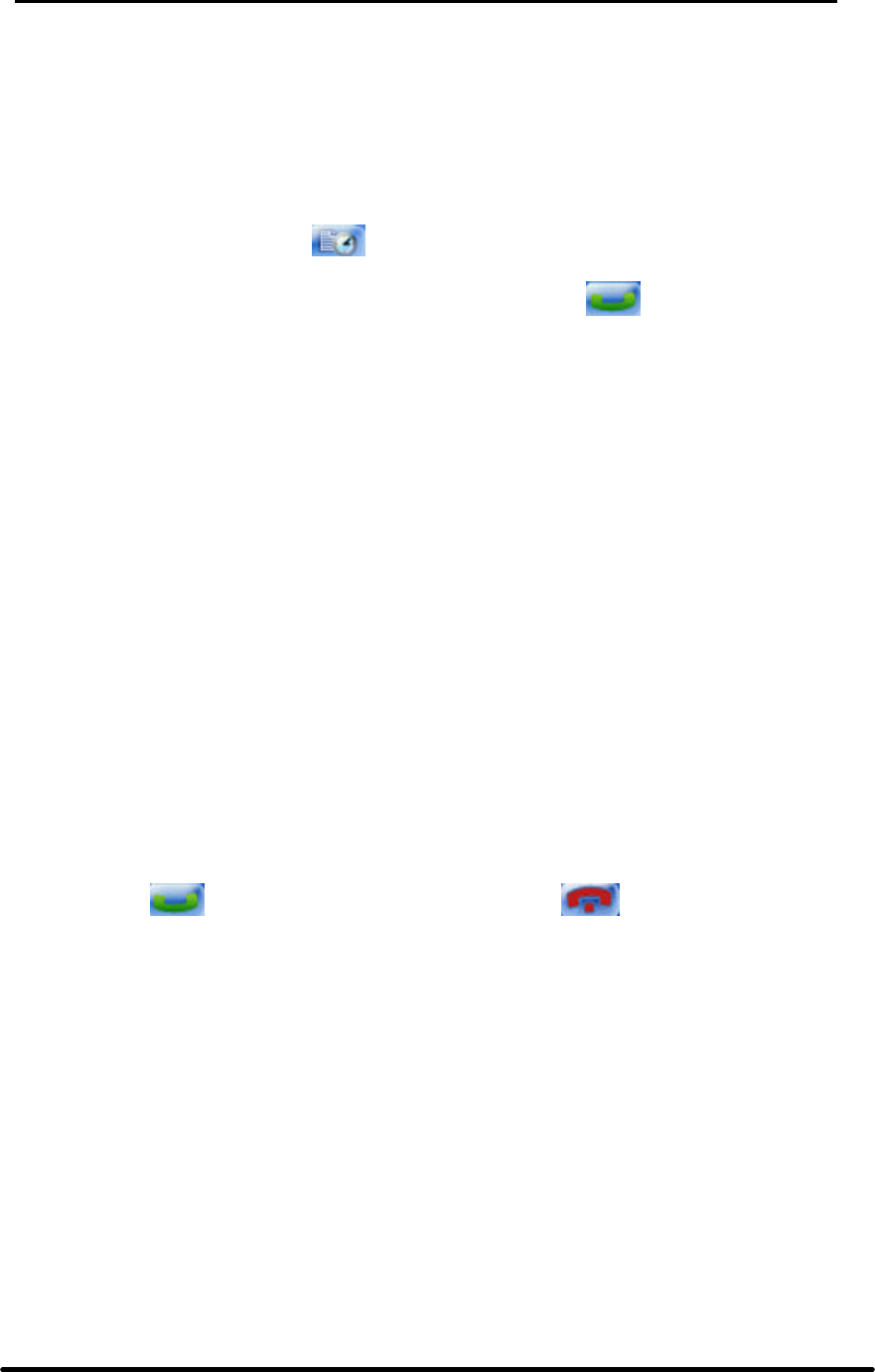
User Guide
Dialer
It is just as easy
to
connect to your voicemail
by
pressing
and holding the
"1"
key.
If
you
have not
specified this number yet,
the dialer will
prompt
you
to
configure
it.
To end
the
call, click on
the
icon showing a red receiver. Call duration will
then
be
displayed and an
entry
in the Dialer log created.
If one or more
callers
have
attempted to contact you in your absence,
the
dialer
will inform
you
accordingly
with
an
on-screen message. If your callers have
not
withheld their numbers, you can call
them
back using
the following procedure:
1. Click
the
Logs
button
which will
open a tabbed
box, in
which the
first
tab is
for missed calls.
2.
Select the
contact
to
be
called then press
the
Call
Receiving a call
Ringer
The
dialer
issues
a ringing
sound to alert you to
a caller
trying to reach you. The
tune played at this
time can depend on how the
caller
is recorded in
your
Contacts
folder. You
can
in fact specify
contacts
in your folder (Work, Friends, Family,
etc.)
and list your callers in
one of
them. Refer
to the
user manual for
your PDA
for
further information
on
this
subject.
The application
may be configured to
play
different
tunes depending on the
category of
the
caller.
Warning!
This will
only work
if the caller’s
number is not withheld.
If
this
is the case, the
application
searches
in the
Contacts
folder
for an entry
associated with
the
number, it then
determines
its category and, if applicable, plays the tune
you
have configured for it.
Information
If the
caller's number has
not been withheld
and if the
caller is
listed in
Contacts
,
the dialer will
display
his or
her
name.
If
he or she is not listed,
only the number will
be
displayed.
If
the caller's
number has
been withheld, the dialer will then display
Number withheld
.
Accepting
/ Rejecting a call
Click the
green button to accept the call and click
the red button
to reject it.
P2-16
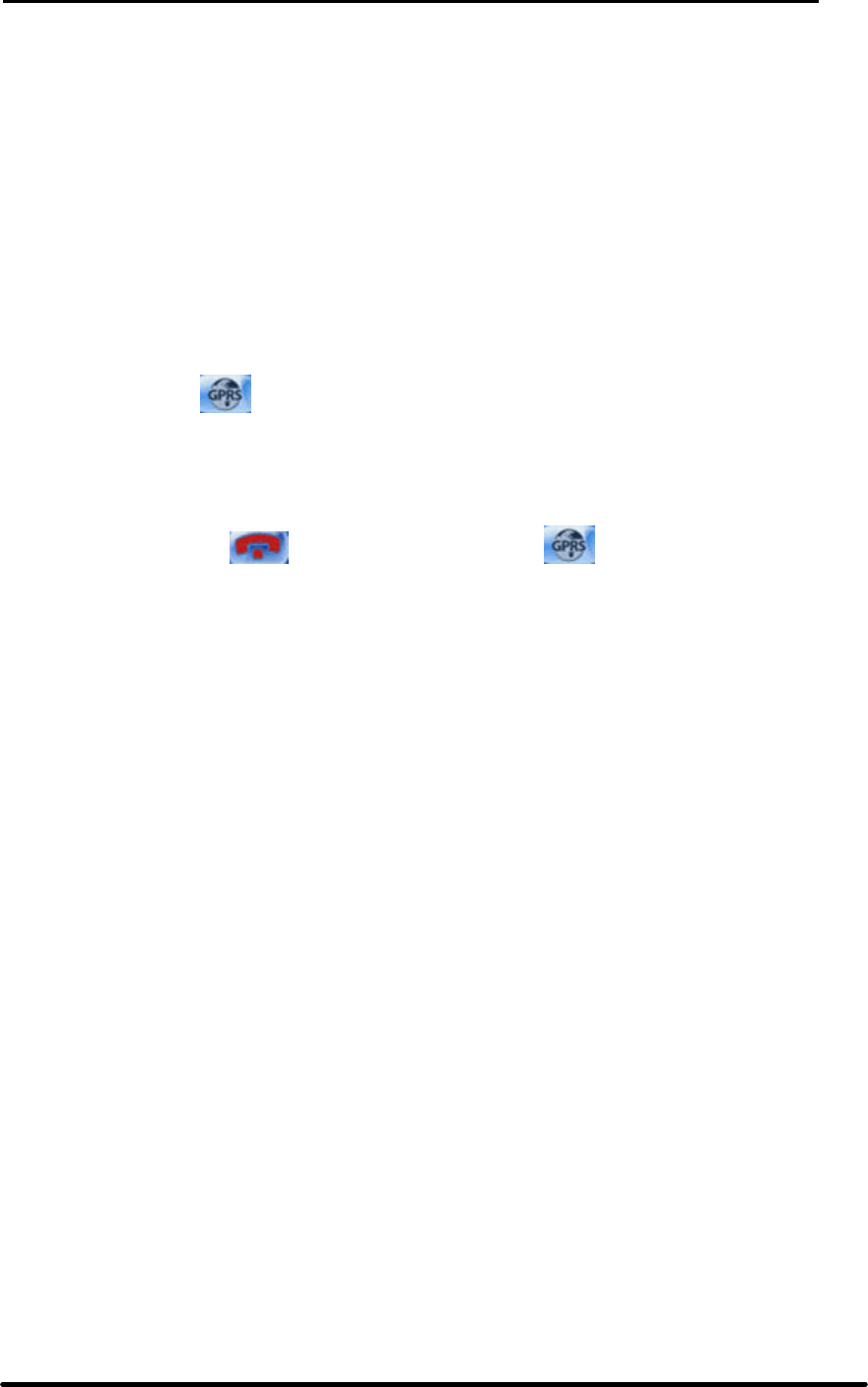
User Guide
Dialer
Receiving SMS messages
SMS messages
are
downloaded automatically
as
soon as your communications
equipment informs
the
application that
messages have
been received. If the message received has high priority, its
content is displayed automatically, otherwise you
have to
use the
Envelope
button to read it (see
SMS, page
25).
Logs
The application
records
dates, durations
and caller identifiers as
the
dialer
is used, dividing
them into
three
categories:
missed calls, incoming calls and
outgoing calls.
You can look up details of these
lists
at any time by pressing the
Logs
button.
This
will take you to
a
tabbed
box listing
the calls
logged
by category and, under
the
Durations
tab,
the various
cumulative totals recorded, with a
facility
for
resetting the
counters.
Remote network access
The dial-up
networking button enables
connections to be
made to remote
services
and
to start
up applications
associated
with them (see page 29
).
Warning!
On
most equipment,
the fact
of
connecting
to
the Internet prevents
the
Dialer from being used.
You
can use either
the red key or
the
dial-up networking button to
close the dial- up
networking session again.
Setup
Accessing setup
Before setting
up the application's dialer function,
select the communications equipment and the
mobile telephony
service provider using
the
Options
command on the
Tools
menu. Next, access
dialer
configuration by clicking
on the
Dialer
link.
Configuring the
answering
machine
You
can add the number of
your
answering machine in the
Network operator
selection
dialogue box
(
Tools
>
Options
menu).
It
will be
dialed automatically
if you
leave
the stylus
resting on the
"1" key
of
the dialer.
P2-17

User Guide
Dialer
Configuring a ringer
1.
From the
main interface,
select
the
Tools
>
Options
menu.
2.
Click
the
Dialer
link. You can specify
the various
tunes
to
be
played according to
the categories to
which the
callers belong in the window displayed.
3.
Select the
type of
call to which a ringer is to be assigned
in the first drop-down
menu in the
Events
field:
Incoming call
,
Incoming fax call
or
Receive SMS
.
4. If you have
selected
Incoming call
,
a
second drop-down list
will be displayed
listing
the various categories
specified in
Contacts
. Select the category
to which
you
would like to associate
a
tune.
5.
Select the ringer
in
the
Sound
drop-down menu.
6.
Use
the
Play
and
Stop
buttons to test the
selected ringer. Once you are happy
with a ringer, click
OK
to
confirm.
7. Repeat these
steps for
each type of call
to which
you would
like
to assign a
ringer.
Calling the
dialer
automatically on
application start-up.
1.
Starting from
the
main interface, select
the
Tools
>
Options
menu.
2. Click
the
Dialer
link.
3. Check
the
Enable on
start-up
box in
the window that
shows
up.
P2-18
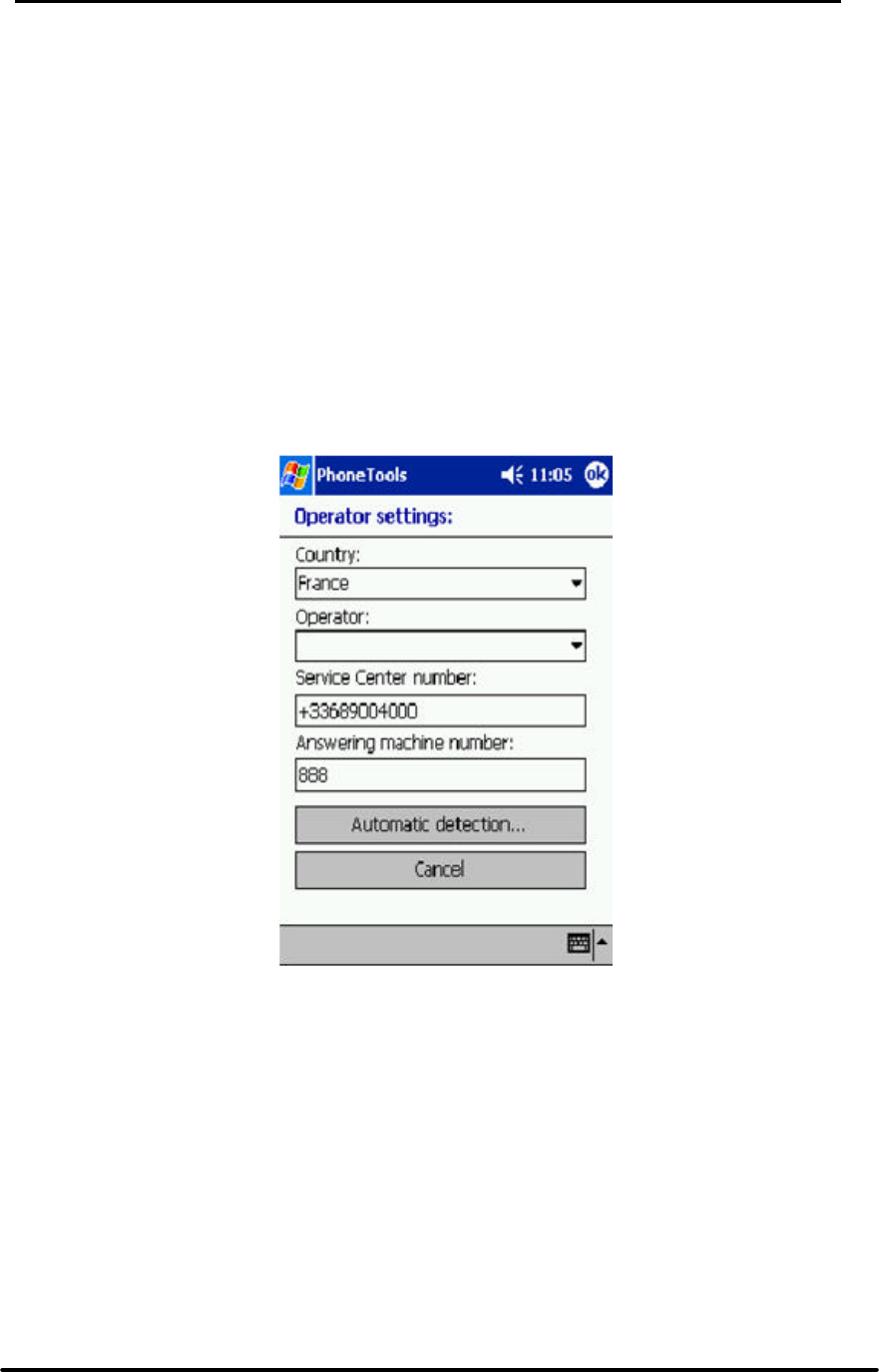
User Guide
SMS
2.3.7 SMS
What is 'Short Message Service' (SMS)?
The
Short Message Service
enables
you to
send messages in
text
format over
a mobile phone
network.
This service
requires
a specific subscription.
Short messages are
sent first to
the
SMS Service Center
run by the mobile phone network,
which then forwards the message to
the recipient.
Received
messages are stored
in the memory. You
cannot receive
any more
new
messages once
this
memory is full.
For this
reason,
ensure you delete them
regularly
or configure the application
so it
transfers
them to your PDA.
SMS settings
Setting up the service
center
1.
Starting from
the
main interface, select
Tools
>
Options
and click on
the
Network operator
link.
2. Select
your country and
mobile telephony service
provider. The
number
of
the
default Service Center is
displayed. If it is not the
number
sent by
your service
provider, you can change it manually.
P2-19

User Guide
SMS
3.
You can
also use the
Detect automatically
button
for
the application to
interrogate your equipment
and configure these settings.
4.
Enter
the number
for
the
answering machine suggested by your service provider.
It will
be
used by the
dialer.
5.
Click
OK
to
confirm.
SMS message settings
1.
From the
main interface,
select
Tools
>
Options
and click on
the
SMS
link.
Sending
Validity period
: if your message
cannot be delivered
immediately, the
service
center can log
it in
and resend it later.
This list
specifies
for how long
your message
will be repeated.
Message type
:
to be used in very specific cases,
this
option
configures
the
message
format
in line with the service center
and
the recipient.
Receiving
Transferring
SMS messages received
: they
may be either copied
or moved
from the
communications
equipment to the
PDA. If
you
opt for the "copy"
mode
(option unchecked), messages received will
accumulate
in the communications
equipment until
it
fills up and
you
risk losing messages
to come.
In this
case you
can always
delete them from the
application's inbox.
2.
Click
OK
to
confirm.
Setting up templates
If you frequently
use
the same
words or sentences
in your
messages, you can
record them in a list
so they can
be
quickly added
to your message. To do
this:
1.
From the
main interface,
select
Tools
>
Options
and click on
the
My text
link.
2.
Select an entry
to be edited
from
the
upper list
and
click
the
Edit
button (arrow
pointing downwards)
for
the
entry to
be
copied to the
editing area.
3.
Once
your
sequence has been
entered, click the
Change
button (arrow pointing
upwards) to
save
it.
P2-20

User Guide
SMS
Sending an SMS message
1. Starting from
the
main interface, select
New
>
SMS
or
click
.
2.
Enter
the recipients' numbers using one
of
the following methods:
ƒ
Direct entry
method: if you have
a
single
recipient only, enter his
or her
information
directly then click the
Next
button.
If
you have more than one
recipient, enter their
numbers
then press
the
Add
button to
add them to
the list.
ƒ
From Phonebook
method:
if
your message recipients
are listed
in
the
Contacts
folder
of your PDA,
click the
Contacts
button
and select
your recipients and their
numbers.
3.
Click
OK
if
the
message content entry
dialog box is
not yet active.
4.
Enter
the text
of the message in
the frame
displayed.
A
character and
SMS
counter
displays size as entry
proceeds. A
typical message
contains up to 160
characters but
the
application
can send
content
longer
than this by linking more
than
one message
together. You
can insert pre-recorded passages of text in
your
message using the
My text
menu.
5. The default
setting
is
for
transmission requests not to
be
implemented
immediately.
This
enables you to
prepare your message
off-line and to
send it
later
on
(to do this,
select it
in the
Outbox
, then
select
Tools
>
Send
).
Check the desired options:
ƒ
Send now
: to send
your
message
immediately.
ƒ
High priority
:
To display the content of
your message directly
on
the
recipient's mobile
phone screen.
ƒ
Request return receipt
: to
receive an
acknowledgement.
ƒ
UCS2 format
:
to ensure compatibility
with pocket PCs
in
different
languages.
6.
Click
OK
.
P2-21

User Guide
SMS
Downloading received SMS messages
-
Select
Tools
>
Retrieve SMS
. If
you
have received SMS
messages on your mobile phone,
they will be automatically
copied or
transferred
to
the
Inbox
. Unread messages appear in
bold. To select
a
tool,
simply click on it.
Viewing an SMS
1.
Select the SMS
you wish to view.
2.
Select
the
Tools
>
View
menu or hold
the
click until a
context
menu is displayed
and select the
View
option on
it. The
content of the
message,
as
well as the sender,
date and
time
of
sending are displayed.
If
the inbox contains a
number of messages,
you
can go directly
from
one
to the next
using the
same
dialog box.
3.
Click
OK
to return to the main
screen.
Note:
Unread messages appear in
bold. To select
a
message,
simply
click
on it.
Replying to an SMS message
1.
In
the
Inbox
, select the message you want
to answer.
2.
Hold
the selection
until a context
menu is displayed in
which
to
select
the
Reply
option, otherwise select
Tools
>
Reply
.
The SMS
send screen is
displayed. The
Mobile phone
and, if
applicable,
Name
and
Company
fields are already filled in.
3.
Click
OK
.
4.
Enter
the message text.
5.
The default
setting
is
for
transmission requests not to
be
implemented
immediately. This
enables you to
prepare your message
off-line and to
send it
later
on
(to do this,
select it
in the
Outbox
, then
select
Tools
>
Send
). Check
the
desired
options referring to
SMS
send options on drafting below.
6.
Click
OK
.
Resending an SMS message
1.
In
the
Sent
folder, select the SMS
message
you
want
to send
again.
2.
Select
Tools
>
Resend
.
3.
Follow
the
standard
procedure for
sending a message (see page2-21).
P2-22

User Guide
SMS
SMS send options on drafting
-
Send now:
the
transmission request
is
implemented as soon as you
click
Send
.
Otherwise, the transmission request is
stored in the
Outbox
.
In order to send
your
message, you
need to
select it,
then select
Tools
>
Send
.
-
High priority
:
check
this box
to display the content of
your message directly
on
the
recipient's mobile
phone screen.
-
Request return receipt
: check this
box to receive an
acknowledgement.
-
UCS2 format
: check
this box to ensure compatibility with non-European
language pocket
PCs.
P2-23
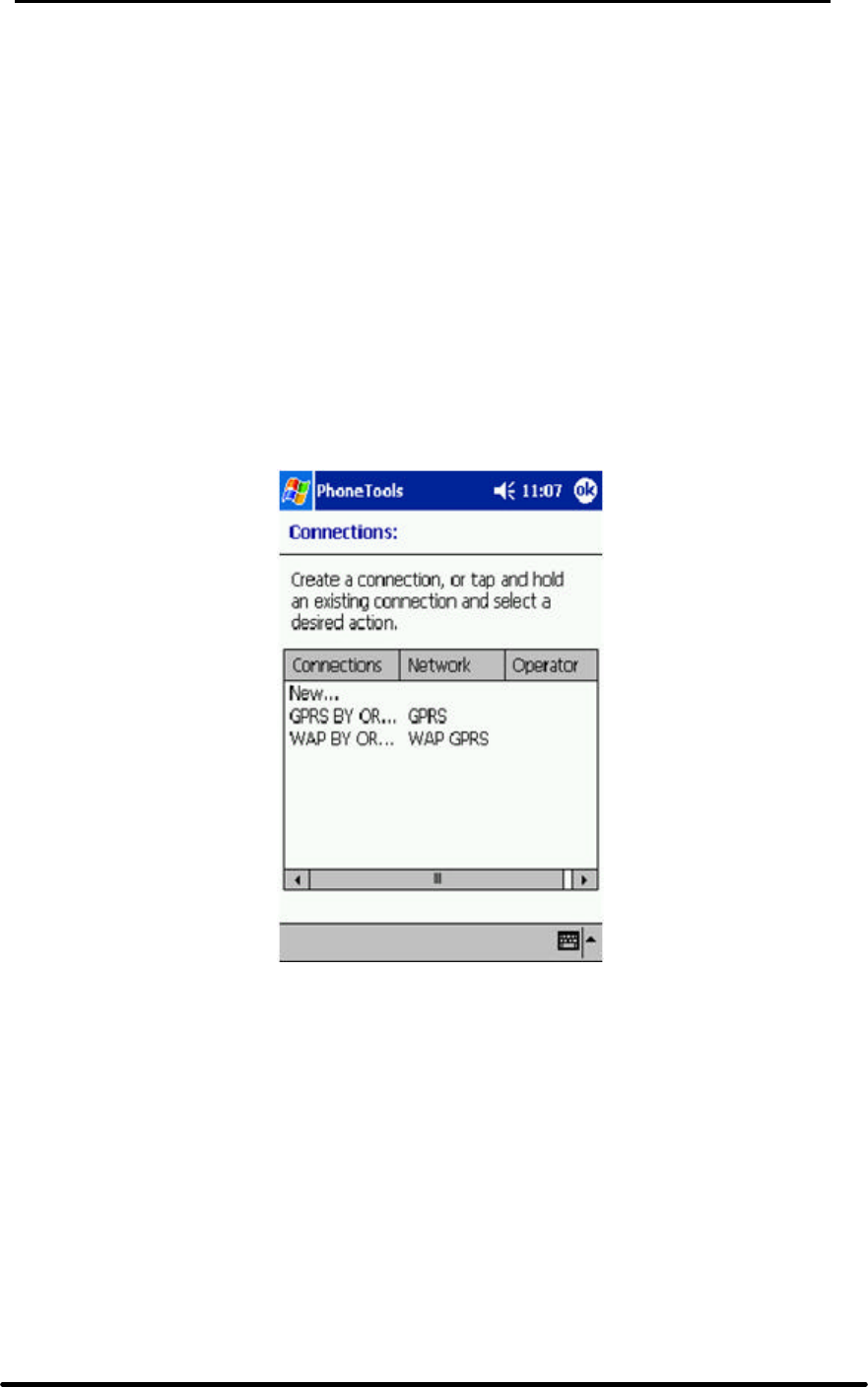
User Guide
Dial-up
networking
2.3.8 DIAL-UP NETWORKING
The
application assists
the
user when setting up dial-up networking, especially
for
Internet access.
Since this
setup
relates
to
the service
provider, you must configure it before anything else.
Configuring the service provider
1.
Starting from
the
main interface, select
Tools
>
Options
and click on
the
Network operator
link.
2.
Select
your country and
mobile telephony service
provider.
Accessing the connections list
1.
Starting from
the
main interface, select
Tools
>
Options
.
2.
Click
the
Dial-up networking
link. The
dialog box displays a
list of
dial-up
configurations handled
by
the application. From this list
you
will be
able to create,
change and delete your configurations.
P2-24

User Guide
Dial-up
networking
Creating an access setup
1.
Access
the
connections
2.
Select
the
New
option from
the list. The
first
box
appears, enabling
you to
enter the name
to be assigned
to your configuration.
3.
Press
the
Next
button.
The application will list
software that can be run while
this connection is live. This choice
is optional.
4. Press
the
Next
button.
If your
service
provider handles
different types of
network
Warning!
Using "high speed"
networks
such as GPRS is
subject
to subscription options.
5.
Select
a
Context number
. Certain telephone devices offer connection profiles
containing
all settings for
use over "high
speed" networks, such
as
GPRS.
In order
to avoid overwriting a pre-programmed setup on your mobile, select
a
free storage
profile using its context number.
If
your
service provider is
recognized
by the
application, you
will be able to
use the
default
settings directly;
to do
this, check the
Use standard settings
box.
ƒ
Specify the
APN or
phone number, Name
and Password settings
as
required. Repeat
for subsequent screens
for
IP
address,
DNS and QOS if
applicable.
6.
Press
Next
.
The following
dialog box
enables a
backup
configuration to be
created
for
high-speed network
access,
to be applied if
the
high-speed connection
is unsuccessful.
If you request
a backup
configuration
to be created, the application
will display the
entry screens
shown
previously for "standard" networks.
Changing an access setup
1. Access
the
connections
list.
2.
Click
the
connection
to be changed
or display
the context menu by holding the
stylus on the connection
to be
changed and select the
Change
option.
3.
Follow the procedure
for
creating access
setups.
Deleting
1.
Access
the
connections
list.
2. Display
the context menu by holding the stylus on the
connection to
be changed
and select the
Delete
option.
P2-25

User Guide
Dial-up
networking
Connecting
You
can set
up the connection
from the
main interface, from the
Tools
>
Dial-up networking
menu or by clicking
on .
-
You
will be
shown
a list
if
more than one access is configured.
-
If no access
has been configured, the
application will
prompt you to access
the Setup
program to
create one.
P2-26